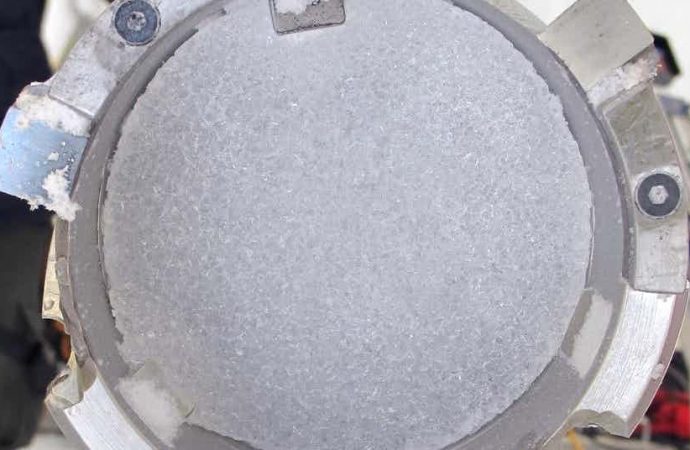ice cores and records from the Black Death show lead entered the air from human activity – and scientists claim “natural background” levels are zero
Analysis of an ice core taken from the Swiss Alps together with records dating from the time of the Black Death have revealed that there is no “natural” level of lead in the air, researchers have claimed.
Once in the body, lead is known to have harmful impacts on health, from behavioural to neurological, reproductive and cardiovascular effects.
With events such as volcanic eruptions releasing lead into the air, it was thought that even before industrial times there was a “natural background” level.
But now researchers say that level has been overestimated, finding that traces of lead trapped within the ice core fell to undetectable levels as the Black Death swept across medieval Europe, shutting down industry and killing more than a third of the continent’s population.
“We have for the first time a lead reading of what it would look like without humans on this part of the planet,” added Chris Loveluck, an archaeologist from the University of Nottingham and co-author of the research.
The findings suggest that even before the industrial revolution, atmospheric lead was primarily a result of human activity. As a result, they add, there is no “safe” background level of lead pollution.
“We have basically been poisoning ourselves for about 2,000 years,” said Alexander More, a historian and climate scientist at Harvard University and another author of the study.
Writing in the journal GeoHealth, the team of historians, archaeologists and climate scientists from the US, UK and Germany describe how they explored historical levels of lead in the air by analysis of a column of ice, known as an ice core, extracted from a glacier in the Swiss-Italian Alps. The team have so far analysed 43 metres of a 72-metre core, thereby delving 2,000 years into the past.
While ice cores previously taken from polar regions stretch as far back in time, contributions to the lead levels from different areas around the world were tricky to unpick. By contrast, researchers say the new ice core offers unprecedented insights. “Because it is geographically precise and located right in the middle of civilisation, the major contribution [of lead] is going to come from Europe,” said More.
By employing both high-resolution and laser-based ultra-high resolution mass spectrometry methods, the team were able to analyse the makeup of the ice core over time in unprecedented detail, matching ice layers to each year. The ultra-high resolution method revealed changes in lead levels down to a month-by-month basis, while radiocarbon techniques and other methods were used to confirm dates.
The team found that the concentration of lead in the ice core fell to negligible levels only once in the 2,000 years covered, becoming undetectable between 1349 and 1353. The period matches historical records of the spread of the Black Death – a plague that spread across Europe and arrived in Britain in 1348.
The researchers also used sophisticated atmospheric models and historical records of where mining and smelting works opened and closed in Europe over the years, to explore where the lead trapped in the ice core was likely to have come from. “We looked at every piece of archaeological evidence for mining and the end of mining in that period across western Europe,” said Loveluck.
The results reveal that British mining and smelting works were likely to have been the major source of lead within the ice core. Further, the team found that the timing of the drop in lead levels seen in the ice core corresponded to a halt in activity at these sites as the plague ravaged England.
The researchers say that taken together, the data tells a compelling story of death, suffering and societal collapse, with the plague leaving communities devastated and the metal production industry without labour.
The findings, say the team, are significant since the rest of the 2,000 year record trapped in the ice core reveals lead levels higher than at the time of the Black Death. “For at least the past two millennia human mining and smelting activities have been the originator of detectable lead pollution in the European continent,” the authors write.
Bert Brunekreef, professor of environmental epidemiology at Utrecht University welcomed the study but said that it was already known that any non man-made lead levels were likely to be very low, adding that the new findings do not mean that the impact of lead on human health is underappreciated.
Eric Wolff, an expert in ice core analysis from the University of Cambridge was enthusiastic about the findings.
“This is really interesting work, and if the dating of the core is confirmed, it makes a fascinating study of the effects of disease on industrial production,” he said.
But Wolff noted that soil dust leads to natural levels of lead in the atmosphere.
“This was much higher in the last ice age when winds mobilised dry soils. Humans and ecosystems had to adapt to higher natural concentrations of lead then, which were only exceeded again in the 20th century with the use of leaded petrol,” he said. “What really matters is whether the lead is available in a chemical form where it can affect living things, and the present study doesn’t address that.”
Source: The Guardian

































Leave a Comment
You must be logged in to post a comment.